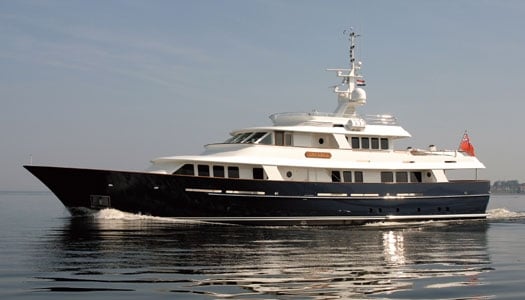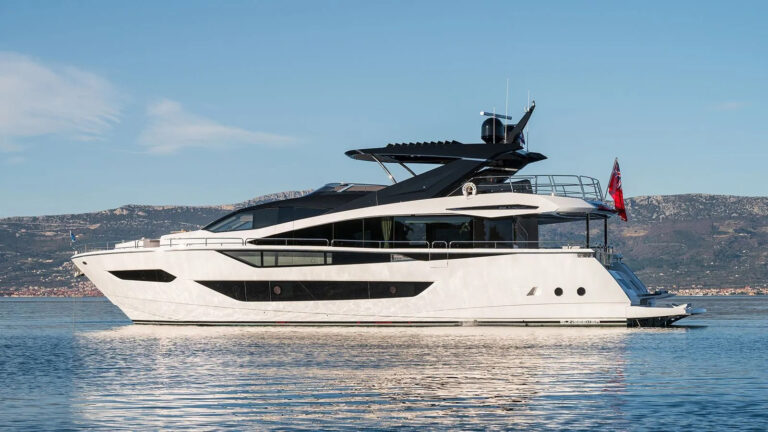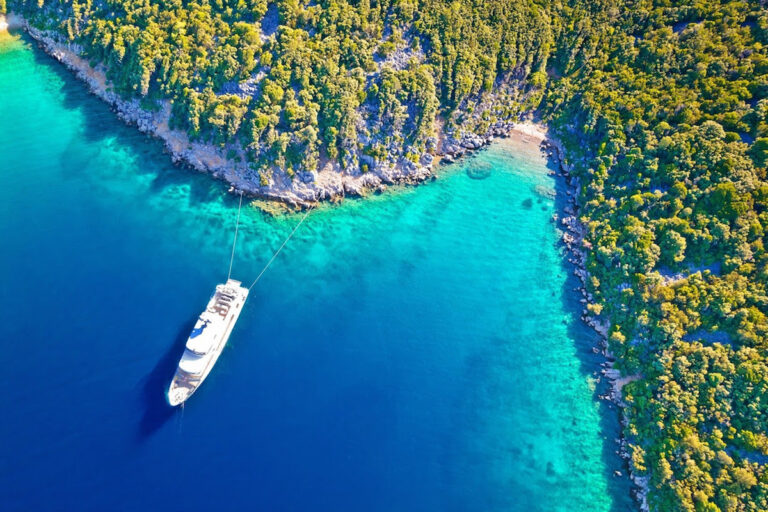
yachting/images/magazine/2006/092006/fea_arcadia_525x300.jpg
Royal Huisman is one of the world’s premier builders of large sailing yachts. Just last year, the famed Dutch yard delivered Athena, a magnificent 295-footer that is one of the largest private sailing yachts ever built, and certainly the largest constructed entirely of aluminum. Even as Athena took shape, however, there were a number of “smaller yachts coming down the line behind her, all still well over 100 feet.
Among them, Arcadia is an attractive and traditionally styled 117-footer from the board of Tony Castro, with an interior by Dick Young. Nothing unusual there, except that Arcadia is a motoryacht, and a rather remarkable one at that.
I’d seen Arcadia a couple of times as she came together at Royal Huisman, but that did little to prepare me for the finished product as I boarded her at the quaint working seaport of Urk, Holland. Like a princess among peasants, she looked more than a bit out of place and eager to be gone-somewhere, anywhere-as tugs and fishboats of every description passed close by.
We soon obliged, with the moving horizon one of the few clues that Arcadia had slipped her moorings and was under way. Arcadia is among the quietest yachts I’ve ever experienced. Even at her full cruising speed of 10 knots, the level of conversation didn’t change as I chatted with Castro in the yacht’s saloon. Sound level measurements by the shipyard at this speed revealed just 48 decibels in the saloon, 47 in the owner’s stateroom, and 50 in the crew mess. By comparison, quiet conversation is about 60 decibels, so we were disturbing the yacht’s peace and quiet, not the other way around.
One significant contribution to Arcadia’s absence of noise is her propulsion system. Her twin Caterpillar engines make their full 540 hp at 1800 rpm. Arcadia also employs deep-reduction gears, ZF W2700s with a ratio of 4.484:1, turning five-blade, five-foot-diameter Wartsila props at 402 turns a minute. The props on a typical yacht with 2400 rpm engines and 2:1 gears are turning three times that fast. In addition, Arcadia’s propeller shafts and their bearings operate within an enclosed, oil-lubricated system by Akerboom, eliminating much of the turbulence and cavitation of open shafting, reducing both noise and vibration.
Castro took considerable pains in much of the development of this, his first major motoryacht commission. Working with MARIN, the well-respected Dutch model basin, the team utilized computational fluid dynamics (CFD) research on MARIN’s computers to explore various hull shapes and minimize propulsive resistance. A traditional tow-test model was also built to verify the computer results, and this physical model was used to check appendage and propeller details.
The choice of material for hull construction is a subject of constant debate, particularly for displacement yachts bound for extreme latitudes. (Arcadia is not ice-classed, but is “overscantling, according to Castro.) For Arcadia, Royal Huisman’s experience with the proprietary Alustar alloy tips the balance, offering advantages in weight and strength over common alloys. This reduction in structural weight reduces the hull’s displacement, correspondingly reducing wetted surface and resistance. True to his sailboat roots, Castro also used part of the weight savings to add internal ballast, lowering Arcadia’s vertical center of gravity and thereby decreasing her waterline beam, further reducing resistance while still maintaining stability.
Other noteworthy features, many coming from the owner’s 16 years of yachting experience, include zero-speed fin stabilizers, by VT Naiad Marine, for comfort at anchor, and a stern anchor tucked into Arcadia’s transom. Castro also reverted to sailboat design in specifying efficient high-aspect-ratio (tall and skinny) rudders, but fitting them with breakaway tips.
Of course, even for a gearhead like me, not all of Arcadia’s charms are buried in the finer points of naval architecture and marine engineering. Also aboard was Jonathan Rhoades, interior designer Dick Young’s project manager, who along with Scott Weaver, the owner’s interior decorator, was responsible for Arcadia’s warm and richly detailed interior. Teak and paneled mahogany were chosen, the perfect materials for Arcadia’s traditional styling. Abundant handrails and fiddles, common on sailboats and older motoryachts are delightfully functional. Doorways and cabinets with arched tops hark back to the days when such shapes were structural necessities. The overheads are white-lacquered planks with mahogany beams, and the planking above the mahogany wainscoting is duplicated on many bulkheads as well. Gimbaled lanterns and classic dome lights, all in brass, complement the dÈcor, while unobtrusive recessed pinlights help bring the illumination level up to modern expectations.
The arrangement, like the yacht itself, is a blend of old and new. Because Arcadia is designed for moderate speed, she carries her buoyancy farther forward than on a higher speed yacht, thus her engineroom is amidships. Guests are accommodated on the lower deck aft, while crew quarters are forward of the engineroom. Two guest staterooms, one with a queen berth and one with twins, open to a foyer adorned with antique barometers. Also sharing this foyer is the full-beam VIP suite, with a sitting room that quickly converts to a fourth stateroom.
The owner’s suite, forward on the main deck, is smaller than on many yachts of this length, thanks to Arcadia’s flush-deck configuration and full-length walkaround side decks. That’s not to say it’s any less grand, however, as the workmanship is superb. There is a large head with double sinks and both tub and shower, adorned throughout in marble, as well as sitting and vanity areas, and spacious lockers to meet the needs of extended time aboard.
The saloon and dining areas are especially well planned. Glass and mahogany cabinetry between the two spaces lend a feeling of intimacy and comfort while still allowing the light and airy feeling that keeps such rooms from seeming progressively smaller after days at sea, an effect carefully carried throughout the yacht.
I’ve spent many paragraphs in the pages of previous issues of Yachting extolling the virtues of Royal Huisman’s construction and outfitting, so there’s no need to repeat myself here. Arcadia is yet another exquisite example of Dutch craftmanship at its best. The only thing missing during my visit was patriarch Wolter Huisman’s broad hand on my shoulder and his smiling pride as he showed off the fruits of his beloved workers’ efforts; he may no longer be there, but the presence of his spirit is palpable. Arcadia, started under Wolter’s supervision and completed under the watchful eye of daughter Alice, now managing director, is every inch a Royal Huisman yacht, even without sails, and Wolter would love her as much as I do.
Contact: Royal Huisman. (011) 31 527 243131. www.royalhuisman.com









